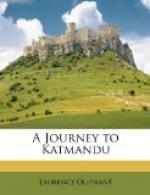There is not, I conceive, any other mountainous country in the world that can boast of possessing so favoured a spot. Throughout its whole length and breadth, not a stone is to be found: it is well watered; its temperature is delightful, the thermometer in the hottest month seldom reaches 75 degrees, in the coldest never falls below 30 degrees; it is sufficiently near the tropics to rejoice in the presence of the warm bright sun even in the depth of winter, while the proximity of the ever snow-capped “Himaleh” prevents the heat being too severely felt in the middle of summer. It rarely freezes in the valley, and never snows, although the hills around, some of which do not exceed 1000 feet, are frequently powdered.
It is impossible to conceive a more enjoyable climate, and the numerous productions of which the valley can boast betoken its genial influences.
I am sorry that I cannot from my own observation testify to the rich variety of its vegetable productions, as the time of year during which I was in Nepaul was unfavourable, but many English forest-trees flourish here,—amongst them, oaks, chestnuts, and pines; rhododendrons also abound, and I observed almost every species of English fruit-tree: in the residency garden all the European vegetables are raised to perfection.
But to return from this digression on the advantages of soil and climate which the valley possesses. The lovely view before us comprised in a glance the grand and majestic scenery of the mountains, with the softer but still animating view of the luxuriant plain, bearing evidence of that large and industrious population whose habitations were so picturesquely grouped throughout it.
We had not nearly satisfied our desire to gaze upon so much that was new and interesting, when we were informed by our attendants that the astrologers had announced the auspicious moment at which the Minister Sahib, or, as we must now call him, Jung Bahadoor Comaranagee, should leave the camp outside the city walls and make an imposing entry into Katmandu.
This lucky hour was now close at hand; and as the entrance of the prime minister into the capital was a scene not to be lost, we hurried down to be in time for the ceremony of his reception.
In a few moments we were rattling in one of the only carriages in Nepaul over one of the only carriage-roads of which it can boast, and soon reached the bridge, near which was pitched a spacious tent. On our way we passed a square lined with soldiers, and the streets were crowded with a motley population, such as it would be vain to endeavour to describe, but which increased in density as we approached the centre of attraction, near which we were obliged to leave the carriage, and were conducted between rows of soldiers by various members of the royal household, each of us being led by the hand in the most affectionate manner. My conductor was a brother of Jung Bahadoor’s, who distinguished himself about a week afterwards




